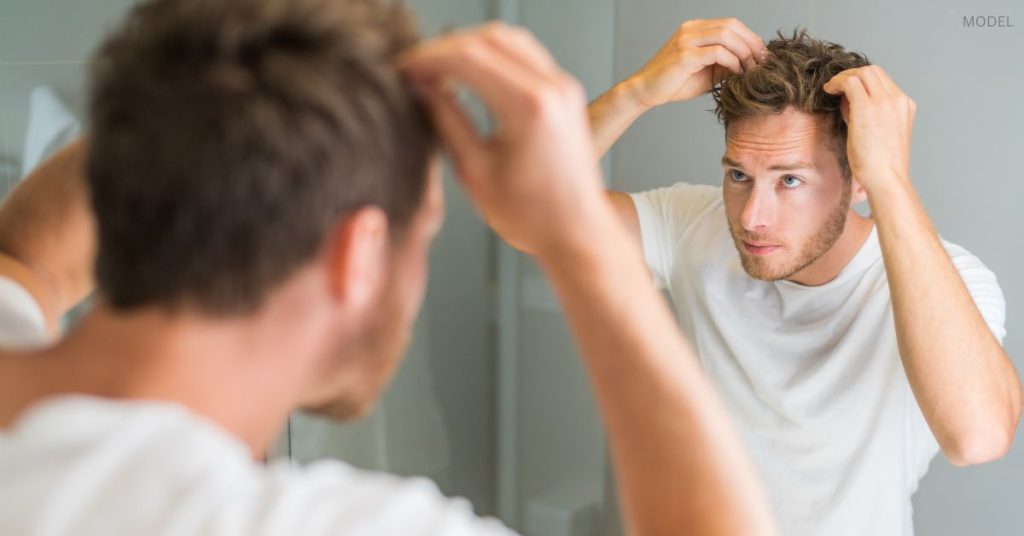Hair loss is an unfortunate fact of life for many men and women. Losing hair can also make you lose self-confidence, feel less vibrant, and look less youthful. Fortunately, many advanced hair restoration options are available today to help you reclaim a fuller head of hair.
Why does hair loss happen, and what can you do about it? Let’s start by explaining the “root” causes and triggers of hair loss. Then, we’ll delve into nonsurgical hair restoration options and treatments that can help you regain your hairline, improve your appearance, and boost your self-confidence. Ready to learn more?
What Causes Hair Loss?
While some hair loss is inevitable for most men and women, premature balding or noticeably thinner hair can signal an underlying issue. Here are some key factors that may contribute to hair loss:
- Aging: As part of the natural aging process, hair follicles stop growing, and hair growth slows.
- Heredity: You may inherit a predisposition to balding, referred to as male or female pattern baldness.
- Stress: Extreme stress can impair hair follicles and prevent growth.
- Hormones: In women, hormonal changes may contribute to hair loss.
- Medical conditions: Anemia, underactive thyroid, diabetes, lupus, and other chronic health issues can impede hair growth.
- Medications: Hair loss can be a possible side effect of certain medications.
- Cancer treatment: Many chemotherapy patients temporarily experience hair loss.
- Nutrition: A nutritional deficiency can slow or prevent hair growth.
- Hair care: Harsh treatments like coloring, perming, or relaxers can cause hair loss.
Remember, it’s not only men who suffer from hair loss. As noted above, factors such as autoimmune deficiencies, stress, and hormonal changes that occur during pregnancy and menopause can leave women with thinning hair or female pattern baldness. Our solutions address hair loss for men and women. During your consultation, we’ll assess your concerns and tailor a treatment plan that accomplishes your unique aesthetic goals.
What Is PRP Hair Restoration?
Platelet-rich plasma (PRP) hair restoration is a process that uses your body’s naturally occurring growth factors. The plasma within your blood can trigger new growth, resulting in thicker, healthier locks.
How Does PRP Hair Restoration Work?
After drawing a small amount of blood from your arm, we use a centrifuge to separate the PRP before injecting highly concentrated platelets into the balding or thinning areas of the scalp. A topical numbing agent is applied to minimize any discomfort throughout the procedure. Overall, it’s a convenient, quick, and relatively painless outpatient treatment that activates healthy hair growth.
Who’s an Ideal Candidate for PRP?
While most healthy men and women can benefit from PRP, it may not be ideal for everyone. If you smoke, take blood thinners, or have a blood disorder or thyroid condition, you may not be an ideal candidate for PRP due to the potential for additional risks.
What Is Alma TED® Treatment?
Alma TED is a non-invasive and needle-free hair restoration treatment uses low-frequency ultrasound technology in combination with a medicated serum to stimulate blood flow to the scalp. The result? Natural hair regrowth that looks (and feels) natural!
How Does Alma TED Work?
Sound wave vibrations increase the amount of hair serum the scalp can absorb, reaching the deeper layers of the skin and hair follicles to boost hair growth.
Who’s an Ideal Candidate for Alma TED?
Alma TED works best for men and women in the earlier stages of hair loss, shedding, or thinning (not fully bald). In comparing Alma TED versus PRP, some patients prefer Alma TED because treatment time is slightly shorter and no needles are required.
What Is KeraLase™ Hair Restoration?
Laser hair restoration is another effective approach to combating hair loss. KeraLase combines cutting-edge Lutronic LaseMD Ultra® laser technology with KeraFactor®, a nutrient-rich serum. As the laser creates microchannels in the scalp, hair follicles absorb the growth factors and proteins in the nutrient-rich serum to activate hair growth.
What Happens During KeraLase Treatment?
We gently massage the KeraFactor serum into your scalp and then use the laser device to administer controlled, precise energy to thinning areas. KeraLase treatments are comfortable and only take about 10 minutes. Like Alma TED, there are no needles, no bleeding, and no downtime!
How Long Will My KeraLase Results Last?
Most patients notice a difference in hair density after their first 2 to 3 treatments, with improvement continuing over the next several months. We recommend 6 treatment sessions performed every 2 weeks for optimal results.
What Are Nutraceuticals?
You can often use vitamin supplements like Nutrafol and Viviscal™ in conjunction with hair loss treatments such as PRP and Alma TED to help address severe hair loss.
How Does Nutrafol Work?
Nutrafol contains key nutrients like curcumin, tocotrienol, and biotin that help support cellular metabolism and nourish hair follicles to promote scalp and hair health.
How Does Viviscal Work?
Viviscal nourishes hair by supplying nutrients to hair follicles that promote hair growth. Specifically, it addresses thinning hair by reducing hair shedding and enhancing hair thickness.
Are you ready to achieve thicker, healthier locks? Explore your hair restoration options with our board-certified dermatologists by requesting a consultation online or calling us at (202) 393-7546 to schedule an appointment.





Leave a Reply